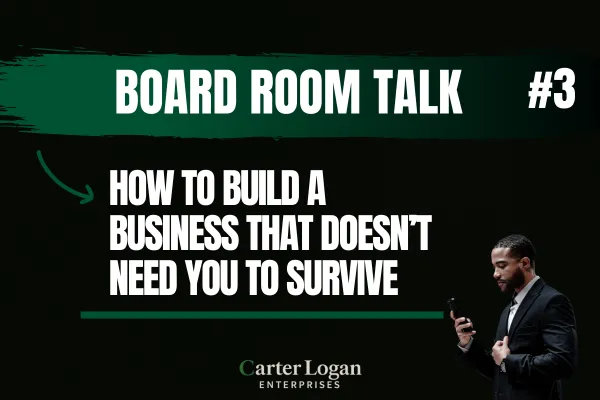
How to Build a Business That Doesn’t Need You to Survive
Because if it falls apart when you take a day off, it’s not a business—it’s a trap.
Introduction: You Didn’t Start a Business to Be a Prisoner
Let’s be real.
You started your business to create freedom.
But somewhere along the way, it turned into a full-time job with unpaid overtime.
You're the salesperson. The service provider. The marketer. The tech support.
If you step away for even a weekend, everything stalls—or collapses.
That’s not freedom. That’s financial handcuffs disguised as entrepreneurship.
If your business can’t survive without you, you don’t own a business. You own a high-stress hustle.
Let’s fix that.
The Real Goal: Build to Remove Yourself
Most people build their business around their personality, their availability, and their hustle.
Smart entrepreneurs build systems, assets, and roles that allow them to step out of the business—without everything falling apart.
The goal isn't to do more.
The goal is to do less of the right things—and build a machine that does the rest.
Step 1: Stop Being the Product
If your offer depends on you being the only person who can deliver the value, you’ve already lost.
Here’s what to audit:
Are you the only one who can coach, teach, consult, or fulfill?
Do clients expect you or the result?
Can your offer be taught, licensed, templatized, or systematized?
If not, you’ve built a personality brand. That’s cool… but that’s not scalable.
Shift from talent-based to system-based delivery.
Step 2: Systematize Everything You Touch More Than Once
Every recurring activity in your business should follow a playbook—not your memory.
Document:
Client onboarding
Content creation
Fulfillment workflows
Sales calls
Internal meetings
The goal is to move from “random chaos” to “repeatable process.”
This is what allows you to delegate with confidence.
Step 3: Automate and Delegate Like a CEO
Ask yourself:
What am I doing that software could do?
What am I doing that a trained team member could do?
What am I doing that nobody needs to do at all?
Then:
Automate it with tools like GoHighLevel, Zapier, or Airtable
Delegate it with SOPs, Loom videos, and clear expectations
Eliminate it if it doesn’t move the needle
Your job is to own the vision, not every task.
Step 4: Build a Team That Owns Outcomes
Hiring isn’t just about getting help.
It’s about building a team that can operate the business without micromanagement.
Key hires to consider:
Operations Manager → runs the backend
Client Success Lead → handles fulfillment
Sales Closer or Setter → handles pipeline
Marketing VA or Content Manager → keeps visibility flowing
Give people roles, outcomes, and decision-making power.
Stop trying to be everyone. Be the owner.
Step 5: Build the Business to Sell (Even If You Never Will)
When you build your business like it’s going to be sold—even if it never is—you force yourself to:
Clean up the systems
Remove owner-dependence
Tighten up the finances
Document everything
Build for longevity, not likes
This mindset forces structure, not just grind.
If it’s not sellable, it’s not sustainable.
Final Word: Build the Business. Buy Back Your Time.
You can either:
Keep doing everything yourself and burn out by year 3
Or build a structure, empower a team, and watch it run without you
This doesn’t mean you stop working. It means you start working on high-leverage decisions—not daily fires.
Your time is your most valuable asset.
Build a business that protects it!
